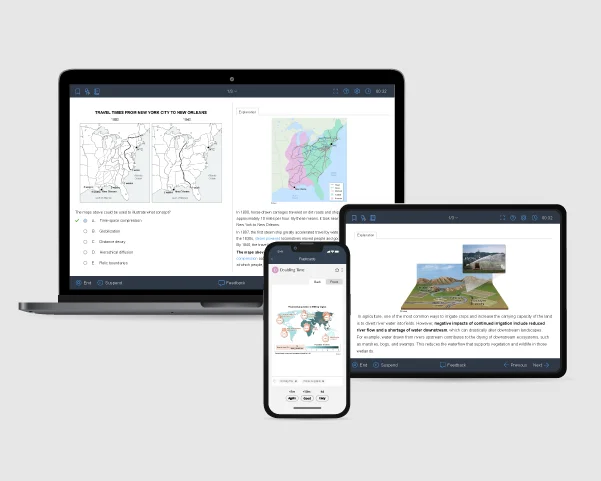Every year, thousands of students take the AP Human Geography (AP HUG) exam. If you have chosen AP HUG and are about to begin studying, understanding the exam structure can help you create a comprehensive and efficient study plan to reach your AP HUG goals. It can also reduce test-day nerves and surprises. This article answers questions that students frequently ask prior to exam day and provides all the necessary information about the format of AP Human Geography exam and structure.
What Is the Format of the AP Human Geography Exam?
The AP HUG exam tests students' knowledge of course skills and objectives. It is two hours and fifteen minutes long and consists of two sections: multiple-choice (MCQ) and free-response (FRQ) questions. Each section makes up 50% of the total exam grade. The following is a breakdown of the AP Human Geography exam format by the number of questions in each section, their duration, and exam weight.
| Section | Question Type | Time Allocated | Weight |
|---|---|---|---|
| Section I | 60 MCQs | 60 minutes | 50% |
| Section II | 3 FRQs | 75 minutes | 50% |
Section I: Multiple Choice
Section I is worth 50% of your overall score. There are 60 multiple-choice questions in this section, allowing for just one minute per question. It includes both individual and set-based questions (five to eight groups of two to three questions each). The MCQs cover the following areas:
- Analyses of maps and spatial information
- Demonstration of spatial awareness of the world
- Interpretation of various patterns and processes
- Regionalization
- Examination of changing location interactions
Section II: Free-Response
Section II accounts for 50% of your overall score and comprises three FRQs that must be finished within 75 minutes, allotting 25 minutes per question. The FRQ section involves making connections between subjects as well as analyzing and evaluating geographical concepts. Question prompts may include verbal descriptions, maps, graphs, photos, and diagrams. Your essays need careful analysis and organization, with points awarded for individual sub-parts rather than the overall answer.

Types of Questions in the AP Human Geography Exam
As mentioned earlier, the AP Human Geography exam structure includes two question types that assess student proficiency in the three “Big Ideas.” However, simply possessing knowledge about the Big Ideas won't guarantee a high score. It’s critical to grasp how to respond to these questions effectively. The following is a list of the seven AP HUG units with their respective weights that you should focus on for your exam.
| Units Tested | Exam Weight | |
|---|---|---|
| Unit 1 | Thinking Geographically | 8–10% |
| Unit 2 | Population and Migration Patterns and Processes | 12–17% |
| Unit 3 | Cultural Patterns and Processes | 12–17% |
| Unit 4 | Political Patterns and Processes | 12–17% |
| Unit 5 | Agriculture and Rural Land-Use Patterns and Processes | 12–17% |
| Unit 6 | Cities and Urban Land-Use Patterns and Processes | 12–17% |
| Unit 7 | Industrial and Economic Development Patterns and Processes | 12–17% |
Section I: Multiple Choice
30-40% of the multiple-choice questions on the AP HUG exam will be based on stimulus material, such as map data, tables, graphs, charts, infographics, images, and/or landscapes. They will involve both quantitative and qualitative references, with each accounting for approximately equal proportions. AP HUG’s multiple-choice question categories are weighted as follows:
| Skill Category | Exam Weight | |
|---|---|---|
| 1 | Concepts and Processes | 25-36% |
| 2 | Spatial Relationships | 16–25% |
| 3 | Data Analysis | 13–20% |
| 4 | Visual Analysis | 13–20% |
| 5 | Scale Analysis | 13–20% |
Section II: Free-Response
Each FRQ presents students with an exact geographical situation or context to assess their ability to articulate, explain, and apply geographical concepts, processes, or models.
Question 1: has no stimuli
Question 2: has one (data, image, or map)
Question 3: has two (data, images, and/or maps).
At least two of the three free-response questions test students' spatial analysis skills. In this section, all five AP HUG skill categories are evaluated with the following weights:
| Skill Category | Exam Weight | |
|---|---|---|
| 1 | Concepts and Processes | 23–29% |
| 2 | Spatial Relationships | 33–43% |
| 3 | Data Analysis | 10–19% |
| 4 | Visual Analysis | 10–19% |
| 5 | Scale Analysis | 10–14% |
The table above illustrates that both the multiple-choice and free-response sections carry equal weight on the exam. Consequently, earning a high score on both sections has an equal impact on your overall AP HUG exam score. It’s advisable to keep this in mind as you prepare for your exam and take enough AP Human Geography practice exams so that nothing catches you by surprise on the exam day.
Need help mastering AP Human Geography and improving your score? Our AP HUG prep course, consisting of a study guide and a QBank, offers detailed coverage of every topic and hundreds of practice questions to set you up for success.
Is the AP Human Geography Exam Hybrid or Fully Digital?
The AP Human Geography Exam is fully digital, which means that you have to take both the MCQ and FRQ sections in the Bluebook testing app.
Understanding the AP Human Geography exam format is the first step towards achieving top scores. Now that you know everything about the AP Human Geography exam structure and what to expect on each section, you are ready to create an effective study plan.

References
- (2024). AP Human Geography. apstudents.collegeboard.org. Retrieved December 11, 2024, from https://apstudents.collegeboard.org/courses/ap-human-geography
- (2020, Fall). AP Human Geography Course and Exam Description. apcentral.collegeboard.org. Retrieved December 11, 2024, from https://apcentral.collegeboard.org/pdf/ap-human-geography-course-and-exam-description.pdf
Read More About the AP Human Geography Exam
AP Human Geography Course and Exam Description
Need a summary of the AP HUG course? Save time by reading the course and description guide, providing clear information on the units, topics, and key concepts of AP HUG.
AP Human Geography Scoring Guide
A complete scoring guide is here! This article will teach you everything about how the AP HUG exam is scored, score distribution, and the average score required for college credit.
AHow P Human Geography Study Guide & Materials
Want to know the most effective strategies for getting the best AP Human Geography score possible? We’ve compiled everything here for you—UWorld’s AP HUG study guide.
Best AP Human Geo Study Guide Comparison
Compare the best AP Human Geo study guides! See how Kaplan, Barron's, and Princeton Review stack up against UWorld for comprehensive exam prep.
Best AP Human Geo Prep Course Review
Searching for top AP Human Geo prep courses? Read this review to compare the best courses and choose the perfect one for your success.
How to Self-Study for AP Human Geo
Want to ace AP Human Geo on your own? Follow this expert self-study guide with tips, tricks, and tools to prepare effectively for the exam.




